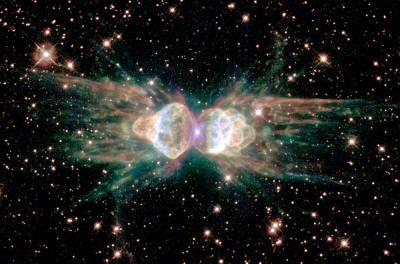|
by Mel Acheson from Thunderbolts Website
Credit: ESO/VISTA/J. Emerson.
Acknowledgment: Cambridge Astronomical Survey Unit
One can see
especially well in the high-resolution image (below) that these currents
consist of double filaments that spiral around each other and are
evenly spaced around the rings.
From an Electric Universe point of view, the image is looking down the axis of the hourglass-shaped galactic current that powers the star.
If viewed from the side, the nebula would have a structure
like that of the Ant Nebula (above image). The hourglass shape is caused by the
Bennett pinch from which the star originated and accumulated its
matter. The rings will constitute secondary circuits, subject to their own pinch effects, which explains the concentration of glowing matter in them.
The outer ring especially appears to
consist of double filaments that twist around each other, exactly
what is expected of an electric current in magnetized plasma. The
bipolar extension of luminosity in the radial filaments (to upper
right and lower left) may indicate a diffusion of ring plasma into
(or from) the further reaches of the hourglass.
This provides an order-of-magnitude sense of the dimensions of the pinch in the current powering the Sun, from which the recently discovered ring of energetic neutral atoms (ENAs) likely originates.
The Sun’s plasma sheath, which the
Voyager space probes are now entering, is located well inside the
hourglass pinch. This sheath acts as the virtual cathode in the
Sun’s discharge circuit and is coupled with the hourglass current in
a manner yet to be determined.
However, it has also resulted in the
establishment of a monopolistic consensus that has driven out
research into alternative hypotheses. The poster boy for this
disturbing consequence is Halton Arp, who was denied telescope time
in 1983 to pursue evidence of intrinsic redshift.
Nothing is left for desperately needed experiments. The once-proud Queen of the Sciences now offers herself for sale to the highest bidder on her street corner.
The field of astronomy is no longer a
seminar of science but a battlefield between mercenaries and exiles.
|


